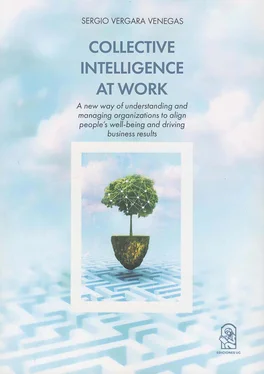Probably the most challenging issue of organizational climate has to do with the purpose, i.e., what is the ultimate purpose of the work. That is where we find major differences in mental models. In my experience, most organizations and, therefore, executives, managers and staff tend to associate organizational climate with how good the coexistence in the workplace is and if there is an environment for good human relationships. What is so striking about this? People don’t connect organizational climate with work practices, that is, with the way decisions are made, differences are resolved, and work and processes are structured. Many climate management programs are built as a parallel plan to the way work is performed. In many cases, they are built as a human capital management responsibility, where the chain of command does not clearly see its role, except to agree that a positive environment is valuable.
Today, the challenge is not to demonstrate the value of the organizational climate, but how to change the way we look at it and its relationship with management and the way activities are carried out to generate results, and consequently, to delve into how this can be done. If the climate is understood as good social relations, the action plans will be oriented to improve coexistence. If it is understood as the improvement of personnel conditions, the plans will be to allocate resources to improve this situation. On the other hand, if the organizational climate is understood within the way of working, we will address the work itself in order to manage it.
This book focuses on organizational climate management and explains in depth the key variables that, when addressed, will generate sustainably positive results in organizational climate surveys, as has been our experience over the years in our work with various organizations.
Rather than focusing the work on the results of the climate survey, this book claims that the score obtained in each of the variables is directly impacted by the factors and the way they are addressed, which are detailed in this book and can be managed with the control panel in Chapter 7.
Trying to Turn a “Soft” Topic into a “Hard” One
Historically, the organizational climate has been a complex issue for organizations and management to understand. First, because of the idea that “you can’t improve what you don’t measure,” the focus has been strongly placed on climate measurement, which generates a series of indicators that are easier to read for those who are used to managing results. But when it comes to managing these “hard” statistics, the classic paradigms are insufficient and often naive.
Indeed, the classic management paradigm for any measurable result is that to the extent that it is below the expected standard, the correct thing to do is to quickly build an action plan to bring the variable to the desired level. But this logic does not work in the same way when faced with a “soft” or purely human variable such as organizational climate. We have seen multiple action plans based on activities such as:
- Making the information on organizational climate available to everyone and raising people’s concerns or requests;
- Implementing a set of activities to make employee relations more bearable, such as birthday celebrations, time off, social activities, stretch breaks, and so on.
Many organizations have seen, with frustration, how the implementation of these measures have a short-term impact but fail to maintain a good climate in the long run. This is partly due to failing to consider the costs that these actions imply and the fact that most of the improvement is based on activities where the administration or management is doing most of the work. These same organizations have been left with an even more frustrating feeling of injustice when the same people who have attended and enjoyed the recreational activities organized by the company through management continue in the same critical stance as before.
The organizational climate is a complex process to understand that requires a systemic view, it cannot be improved or acted upon from the logic “A produces B, therefore if we want B, we must do A.” It is the type of situation that Heifetz defines as an “adaptive challenge” (Linsky & Heifetz, 2002), that is, a change that cannot be achieved by exercising authority or giving the most logically correct answer, but requires a shared commitment by all to a common purpose, which is not always so easy to discover.
The Influence (and Pressure) Of Social Ranking on the Management of Organizational Climate
In the last decade, because of development and social trends, the demand on organizations to be “good citizens” has led to the incorporation of new standards regarding the environment, community, safety, quality, customer responsiveness and, of course, employee relations. It has become important for companies to be good workplaces in the eyes of society, as a way of appearing socially responsible, modern, and attractive to business, social and political stakeholders, and to “show” who is who when it comes to caring about people.
The list of the best companies to work for and the desire to be included in this ranking, in addition to approaching organizational climate from an “activity plan for good coexistence” perspective, has unwittingly led the management of the organizational climate to an often-transactional space, where the company gives in exchange for a good result.
This is why it is so necessary to ask ourselves whether people and executives know what the basis for a good or bad organizational climate is and what actions are required of them in this regard. It is common to hear the expression “we are all responsible for the work environment” used in the sense that we are all equal or have the same role in improving it. Implicit in this phrase, there is a deep confusion about how different roles impact the organizational climate, given that senior managers, middle managers, and employees do not deal with the same aspects.
Think of this as a family analogy, could you imagine a relationship with your children where you have to give them everything they want because that’s the only way they will be happy? What would they learn in this situation? That if they complain, they can get more, that their parents should solve their problems, that they don’t have to do any special work, their parents do. In short, as Shakespeare puts it, how sharper than a serpent’s tooth it is to have a thankless child. We all know that educating also implies teaching the exercise of freedom with responsibility. Establishing a paternalistic bond, on the other hand, ends up making the relationship childish.
The Evolutionary Model of Organizational Climate
Through years of experience working on this subject with national and international organizations in different industries, this book develops and proposes the evolutionary model of organizational climate, which includes five essential principles:
1. The organizational climate is a relationship, as is its management.
2. What is most visible is not necessarily the deepest issue.
3. The management of the organizational climate requires action from different roles.
4. If relationships mature, so does the management of the organizational climate.
5. There is a hierarchical ranking in the working dimensions of organizational climate.
These principles are supported by a set of practical tools, all of which are integrated into a control panel.
The evolutionary model is structured on the basis that managing the organizational climate is learning to deal with a relationship and the variables that compose and affect it. In our experience, if the management plan used by the company to address the organizational climate incorporates these factors in a comprehensive manner, the survey results are substantially better and more sustainable.
Читать дальше












